
Gemological Information for Kyanite
| Color: | Light to Dark Blue, Colorless, Gray or Brown (Banded with Blue) |
| Crystal Structure: | Triclinic |
| Refractive Index: | 1.716 – 1.731 |
| Durability: | Poor |
| Hardness: | 6 to 7.5 or 4 to 5 (Depending on Angle) |
| Family: | |
| Similar Stones: | Idocrase, Epidote, Sapphire, Tanzanite, Spinel |
| Treatments: | None Known at this Time |
| Country of Origin: | U.S., Russia, India, Pakistan, Myanmar, Kenya, Brazil |
Kyanite Care
| Ultrasonic Cleaning: | Never |
| Steam Cleaning: | Never |
| Warm Soapy Water: | Safe |
| Chemical Attack: | Not Attacked |
| Light Sensitivity: | Stable |
| Heat Sensitivity: | Sensitive |